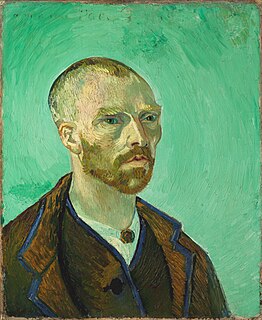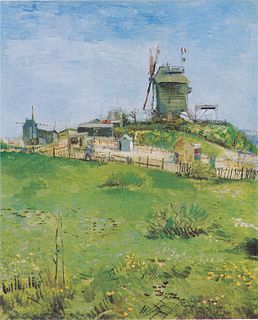 W
WAgostina Segatori Sitting in the Café du Tambourin was painted by Vincent van Gogh in 1887. Agostina Segatori owned the Café du Tambourin that Van Gogh knew intimately. It was a gathering spot for Parisian artists, a place where their work was exhibited. Van Gogh, unable to pay in cash for his meals, exchanged paintings for his fare. The paintings then adorned the restaurant. He held a special exhibit of his Japanese prints in the café as well. His connection with Agostina and the cafe came to a sad end when she went bankrupt and van Gogh's paintings were confiscated by creditors. This painting, however, demonstrates an artistic discovery that culminated in his unique, creative style not quite on the brink of being understood and revered.
 W
WAsnières, now named Asnières-sur-Seine, is the subject and location of paintings that Vincent van Gogh made in 1887. The works, which include parks, restaurants, riverside settings and factories, mark a breakthrough in van Gogh's artistic development. In the Netherlands his work was shaped by great Dutch masters as well as Anton Mauve a Dutch realist painter who was a leading member of the Hague School and a significant early influence on his cousin-in-law van Gogh. In Paris van Gogh was exposed to and influenced by Impressionism, Symbolism, Pointillism, and Japanese woodblock print genres.
 W
WCopies by Vincent van Gogh form an important group of paintings executed by Vincent van Gogh between 1887 and early 1890. While at Saint-Paul asylum in Saint-Rémy-de-Provence, France, where Van Gogh admitted himself, he strived to have subjects during the cold winter months. Seeking to be reinvigorated artistically, Van Gogh did more than 30 copies of works by some of his favorite artists. About twenty-one of the works were copies after, or inspired by, Jean-François Millet. Rather than replicate, Van Gogh sought to translate the subjects and composition through his perspective, color, and technique. Spiritual meaning and emotional comfort were expressed through symbolism and color. His brother Theo van Gogh would call the pieces in the series some of his best work.
 W
WJaponaiserie was the term the Dutch post-impressionist painter Vincent van Gogh used to express the influence of Japanese art.
 W
WList of drawings by Vincent van Gogh is an incomplete collection of drawings by the Dutch artist Vincent van Gogh (1853–1890) that form an important part of his complete body of work. The listing is ordered by year and then by catalogue number. While more accurate dating of Van Gogh's work is often difficult. As a general rule the numbering from Jan Hulsker's catalogue is more precise chronologically
 W
WList of works by Vincent van Gogh is an incomplete list of paintings and other works by the Dutch artist Vincent van Gogh (1853–1890). Little appreciated during his lifetime, his fame grew in the years after his death. According to the legend van Gogh sold only one painting, The Red Vineyard, bought for 400 francs by the painter and art collector Anna Boch. Today, he is widely regarded as one of history's greatest painters and an important contributor to the foundations of modern art. Van Gogh did not begin painting until his late twenties, and most of his best-known works were produced during his final two years. He produced more than 2,000 artworks, consisting of around 900 paintings and 1,100 drawings and sketches. In 2013, Sunset at Montmajour became the first full-sized Van Gogh painting to be newly confirmed since 1928.
 W
WThe Montmartre paintings are a group of works that Vincent van Gogh made in 1886 and 1887 of the Paris district of Montmartre while living there, at 54 Rue Lepic, with his brother Theo. Rather than capture urban settings in Paris, van Gogh preferred pastoral scenes, such as Montmartre and Asnières in the northwest suburbs. Of the two years in Paris, the work from 1886 often has the dark, somber tones of his early works from the Netherlands and Brussels. By the spring of 1887, van Gogh embraced use of color and light and created his own brushstroke techniques based upon Impressionism and Pointillism. The works in the series provide examples of his work during that period of time and the progression he made as an artist.
 W
WLe Moulin de la Galette is the title of several paintings made by Vincent van Gogh in 1886 of a windmill, the Moulin de la Galette, which was near Van Gogh and his brother Theo's apartment in Montmartre. The owners of the windmill maximized the view on the butte overlooking Paris, creating a terrace for viewing and a dance hall for entertainment.
 W
WOutskirts of Paris are paintings that Vincent van Gogh made in 1887, while he was living in Paris with his brother Theo.
 W
WPortrait of Père Tanguy, painted by Vincent van Gogh in 1887, is one of his three paintings of Julien Tanguy. The three works demonstrate a progression in van Gogh's artistic style after his arrival in Paris. The first is somber, and formed from a simple composition. The second introduces van Gogh's Japanese prints. The last and most advanced in style, skill and color integrates Japanese, Impressionist, and other influences on the Parisian artist community. This painting conveys a sense of serenity that van Gogh seeks for himself. This last painting of Tanguy is in the Musée Rodin, Paris.
 W
WSeine (paintings) is the subject and location of paintings that Vincent van Gogh made in 1886. The Seine has been an integral part of Parisian life for centuries for commerce, travel and entertainment. Here van Gogh primarily captures the respite and relief from city life found in nature.
 W
WStill life paintings by Vincent van Gogh (Paris) is the subject of many drawings, sketches and paintings by Vincent van Gogh in 1886 and 1887 after he moved to Montmartre in Paris from the Netherlands. While in Paris, Van Gogh transformed the subjects, color and techniques that he used in creating still life paintings.
 W
WTorso of Venus and a Landscape is a sketch by Post-Impressionist artist Vincent van Gogh. It now resides in the Van Gogh Museum in Amsterdam.
 W
WTrees and Undergrowth is the subject of paintings that Vincent van Gogh made in Paris, Saint-Rémy and Auvers, from 1887 through 1890. Van Gogh made several paintings of undergrowth, a genre called "sous-bois" brought into prominence by artists of the Barbizon School and Impressionists. The works from this series successfully use shades of color and light in the forest or garden interior paintings. Van Gogh selected one of his Saint-Rémy paintings, Ivy (F609) for the Brussels Les XX exhibition in 1890.
 W
WVase with Poppies is a painting made by Vincent van Gogh in Paris in 1886.
 W
WVase with White and Red Carnations is a work by Vincent van Gogh. It is an oil on canvas painting in a private collection, painted in the summer of 1886 in Paris. The painting depicts white and red carnation flowers in a gold and dark brown vase.
 W
WView of Paris from Vincent's Room in the Rue Lepic is a painting by Dutch post-impressionist artist Vincent van Gogh.
 W
WIn 1887, while Vincent van Gogh was residing in Paris, he executed an oil painting commonly known as Wheat Field with a Lark.
 W
WWheat Fields is a series of dozens of paintings by Dutch Post-Impressionist artist Vincent van Gogh, borne out of his religious studies and sermons, connection to nature, appreciation of manual laborers and desire to provide a means of offering comfort to others. The wheat field works demonstrate his progression as an artist from the drab Wheat Sheaves made in 1885 in the Netherlands to the colorful, dramatic paintings from Arles, Saint-Rémy and Auvers-sur-Oise of rural France.
 W
WA Woman Walking in a Garden was painted by Vincent van Gogh in 1887. As the title indicates, it depicts a woman walking through a garden. Greenery is everywhere and numerous trees can be seen in the background.